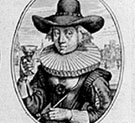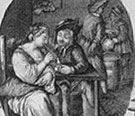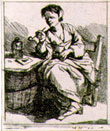> DRY
DRUNK
QUESTIONS OF GENDER
As tobacco "drinking" gained popularity, it began to appear with increasing
frequency in literature and the visual arts, presented sometimes as new and
fashionably sophisticated, but more often as a dubious activity, linked to
the lower, libidinous classes, be they sailors, peasants, or workmen. If
it gradually became de rigueur for a respectable man to smoke, women remained
steadfastly on the margins of recreational tobacco use. The early explorers
unanimously reported that even in native American cultures women used little
or no tobacco, and in the rare 17th- and 18th-century images that depict
a European woman with a pipe, she tends to be of unsavory character. The
activity of smoking or even just holding a pipe was suggestive of a variety
of character traits, supplying machismo to the sailor or hunter, and sophistication
to the gentleman. On the other hand, the woman who smoked was consistently
labeled as sexually promiscuous or otherwise disreputable. The verb "to pipe" continues
to have lewd connotations in languages such as French and Dutch, adding further
support to this perception of the masculine, carnal implications of smoking.
The earliest examples in this section clearly reinforce this stereotype,
but here, as in other genres, the situation modified in the 18th century.
A more even-handed sense of humor took over, so that a rustic husband and
wife smoking together look equally ridiculous and, moreover, singularly out
of sync with their libidinous sides. When George Woodward dreamed up his
ironic women's club in 1792, responding, no doubt, to the proliferation of
gentlemen's clubs in his day, and giving, in his book at least, separate
but equal rights to the grandes dames of the age, he included among the official
rules of the club the decree that all fines be expended in snuff, perhaps
a slightly more ladylike means of consumption, but still within a preeminently
gentlemanly sanctuary.
29
George M. Woodward (British, 1760–1809)
The Rights of Women (Portrait of Judith Tyler, President of the Society)
Etching and aquatint in his: Elements of Bacchus; or, Toasts and Sentiments,
Given by Distinguished Characters. London: William Holland, 1792
Print Collection, Cadwalader Fund
According to Woodward, "this Book is solely intended to promote Mirth
and Good-Humour," accomplished with a series of pseudo-portraits of "the
Bon[s] Vivants of this Kingdom." Although women's and mixed-sex clubs did
exist in England, they were purportedly not quite like men's clubs, with
stricter rules, and all-powerful patronesses –witness the intimidating
Mrs. Tyler. Besides dictating that "all fines . . . be expended in snuff," the
rules of this women's club also forbid anything "of the Male kind to be
admitted, on any account whatever"; each lady was allowed one bottle after
dinner, "before the general discourse concerning Politics takes place."
30
Crispijn II de Passe (Dutch, 1597–ca. 1670)
A London merchant and his wife
Engraving in his: Les Abus du Mariage [The abuses of marriage]. N.p.,
1641
Spencer Collection
 While in late 18th-century England there was room to joke about female
tobacco consumption, if a middle-class married woman of the 1640s was seen
with a tobacco pipe, the implication was that she was cuckolding her husband.
The pipe provided yet another way of setting a household upside down, and
giving an aggressive woman the upper hand. The trilingual text informs
the viewer that, while her merchant husband works hard to earn their keep,
Mistris D meets with her lover on the Thames.
While in late 18th-century England there was room to joke about female
tobacco consumption, if a middle-class married woman of the 1640s was seen
with a tobacco pipe, the implication was that she was cuckolding her husband.
The pipe provided yet another way of setting a household upside down, and
giving an aggressive woman the upper hand. The trilingual text informs
the viewer that, while her merchant husband works hard to earn their keep,
Mistris D meets with her lover on the Thames.
31
Unidentified (French, 2nd half 17th century?)
A woman smoking a pipe in an inn
mounted inside:
Michiel Mousyn (Dutch, b. ca. 1630, active in Paris)
after Gerbrandt van den Eeckhout (Dutch, 1621–1674)
Oval ornamental frame
Two engravings in a collection of ornament prints, n.d.
Print Collection, Kennedy Fund
 The heat of passion is implicated in the act of the prostitute lighting
her pipe in the pot of coals being proffered by her client. The collage
effect –the tavern scene was trimmed to size and pasted into the
ornamental frame –acts as a reminder that prints were used in a variety
of ways in the past. Although the prints in this album principally show
the variety of ornament available to the artist, craftsman, or collector,
in this case, the elaborate frame has a more immediate practical application.
The heat of passion is implicated in the act of the prostitute lighting
her pipe in the pot of coals being proffered by her client. The collage
effect –the tavern scene was trimmed to size and pasted into the
ornamental frame –acts as a reminder that prints were used in a variety
of ways in the past. Although the prints in this album principally show
the variety of ornament available to the artist, craftsman, or collector,
in this case, the elaborate frame has a more immediate practical application.
32
Cornelis Bega (Dutch, 1620–1664)
Woman smoking a pipe
Etching, n.d.
Print Collection

33
Cornelis Bega (Dutch, 1620–1664)
Amorous couple
Etching, n.d.
Print Collection, Samuel Isham Collection
Seventeenth-century Dutch artists were masters at representing themes
of love in seemingly everyday settings. The relaxed couple, with their
supply of gin and tobacco, is a good example of the low end of this specialty.
The image of the leering lone woman smoker, with her bottle of gin and
supply of tobacco in its paper beside her, is packed with suggestive details
placing her outside the realm of respectability, as a rather too independent –i.e.,
masculine –woman.
34
Francesco Bartolozzi (Italian, active in Britain, 1727–1815)
after Barker (British, last quarter 18th century)
The woodman
Color stipple engraving with additional hand-coloring, n.d.
Print Collection, Cadwalader Fund
The woodsman-hunter, accompanied by his attentive if somewhat wild-looking
dog, presents the other end of the gender spectrum: masculinity, enhanced
by the pipe, in an earthy woodsman, who epitomizes the term.
35
James Gillray (British, 1757–1815)
Matins at D-wn-ng College, Cambridge
Hand-colored etching, published by Hannah Humphrey, March 28, 1810
Arents Tobacco Collection
Sir Busick Harwood, professor of anatomy at Cambridge, a "bon-vivant,
very witty, and very licentious in conversation," lies in bed with his
corpulent wife, both of them puffing away, framed as if on stage by the
bed curtains. The note on the edge of the bed near the professor suggests
that he is not well –is this his healthy morning pipe, or the cause
of his illness? The wife's corpulence, coupled with her furious smoking
of the pipe and the intense, frightened look cast upon her by her husband,
combine to give her a rather fierce look. The print was, incidentally,
published by Gillray's customary –female –publisher.
36
Abraham Allard (Dutch, ca. 1676–1725)
Zo luchtig als de rook licht Guurtje 't voetjen op [Light as smoke
Guurtje raises her tiny foot]
Etching, ca. 1700
Print Collection, David McN. Stauffer Collection
 According to the verse, sprightly old Guurtje dances lightly with her
pipe in her hand, while her fiddle-playing partner, Klaas, prefers a more
substantial mug of beer.
According to the verse, sprightly old Guurtje dances lightly with her
pipe in her hand, while her fiddle-playing partner, Klaas, prefers a more
substantial mug of beer.



